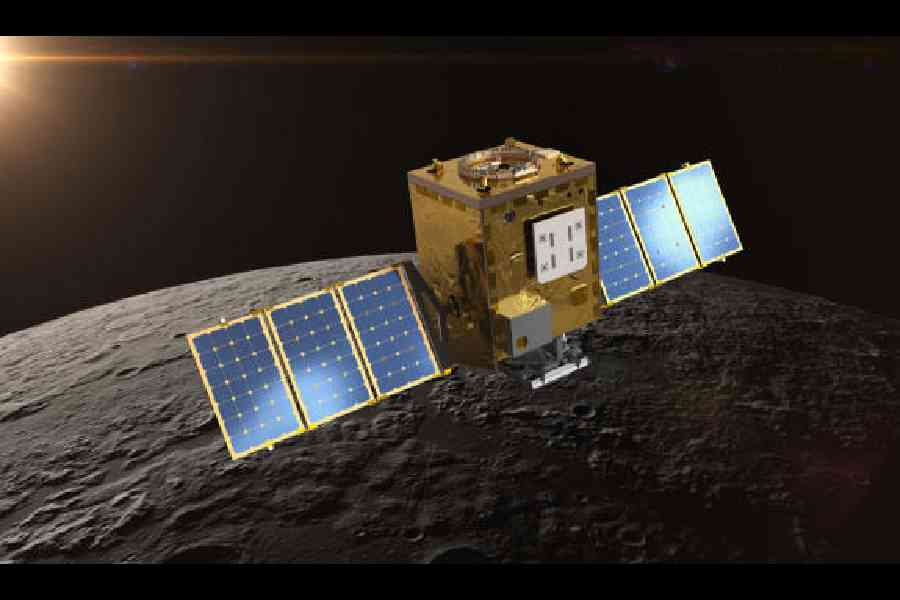The moon is not bone dry, scientists now know. But how many drops of water will thirsty astronauts find? No one knows for sure.
A robotic Nasa spacecraft called Lunar Trailblazer, which launched on February 26 from Kennedy Space Center in Florida, US, is aiming to provide a detailed map from orbit
of the abundance, distribution and form of water across the moon.
The Lunar Trailblazer tagged along for the ride to space on the same SpaceX Falcon 9 rocket as Athena, a commercial lunar lander built by Intuitive Machines of Houston, US, which will deploy a Nasa instrument to drill on the moon and sniff for water vapour.
Athena will study one spot on the moon. Lunar Trailblazer will provide a global picture of water on the moon.
“That is another exciting thing for us as we get more science into space with one launch,” Nicola Fox, the associate administrator for Nasa’s science mission directorate, said during a news conference before the launch.
Less than an hour after lift-off, Lunar Trailblazer and Athena went their separate ways. Athena is taking a direct path to the moon while Lunar Trailblazer set off on a meandering but fuel-efficient journey and will take four months to reach its destination.
On February 27, Nasa reported that the spacecraft was experiencing “intermittent power system issues” and mission controllers at the California Institute of Technology in the US had lost contact with the spacecraft earlier in the day.
Several hours later, Lunar Trailblazer turned on its transmitter, and mission controllers were trying to diagnose the problem and come up with possible fixes, Nasa said.
If Lunar Trailblazer is able to make it to lunar orbit, it will make observations of the moon’s surface for at least two years.
One area of interest is the nature of water in the moon’s sunlit regions.
“Does it change as a function of the time of day?” Bethany Ehlmann, a professor of planetary science at the California Institute of Technology who serves as the mission’s principal investigator, said in an interview. “You could think about it as almost like a frost coming and going.”
For decades, the moon has been regarded as a world devoid of water. But beginning the mid-1990s, spacecraft found evidence of ice in the eternal shadows of craters in the moon’s polar regions.
In 2009, Nasa slammed a rocket stage into one of the craters. The distinct colour signatures of water were seen in the debris kicked up by the impact, confirming the earlier hints.
That same year, scientists made a surprising discovery that water was observed not just inside the polar craters, but all around the moon. That came from observations of reflected light by a Nasa instrument aboard Chandrayaan-1, India’s first lunar orbiter.
If water is somehow more widespread, that could ease future settlement of the moon, especially if significant amounts of water could be easily extracted from the soil. The water molecules could then be split to produce oxygen for breathable air for astronauts. Hydrogen and oxygen could also be used to fuel rockets or generate power.
However, the instrument aboard the Indian spacecraft was designed to identify minerals on the surface and did not quite cover the swath of wavelengths needed to identify exactly how the water was arranged.
The molecules could have been stacked as crystals of ice or stuck to the surface of minerals — what scientists call adsorbed water. Those forms of water would probably not be very difficult to collect.
But the signal might also point to hydroxyl, a molecular group consisting of one hydrogen atom and one oxygen atom, as opposed to the two hydrogen atoms and one oxygen atom of water.
Hydroxyl would most likely be trapped inside rocks but could be released as water if heated to about 1,000 degrees Fahrenheit or more. That would require energy-guzzling ovens to bake piles of rock.
The Lunar Trailblazer is carrying a scientific sensor — built by Nasa’s Jet Propulsion Laboratory in California — that is similar to the one that was aboard Chandrayaan-1. But the new instrument is more advanced and covers all of the wavelengths needed to differentiate between ice, adsorbed water and hydroxyl.
The instrument can even make observations in the shadowed regions of the moon, which are not actually completely dark because sunlight often bounces indirectly into the crater. “That is the most fun part,” Ehlmann pointed out. “It’s effectively a sort of double bounce of light.”
A second instrument, built by the University of Oxford in England, will measure the temperature of the surface. “The two instruments work together to get this simultaneous data set of water temperature and mineral composition all at the same time at the same place,” Ehlmann said.
The Lunar Trailblazer is one in a series of lower-cost, higher-risk robotic science missions by Nasa. The cost of building and operating the spacecraft is $94 million. But as a secondary payload on the Intuitive Machines mission, the cost of getting to space was only $8 million, much less than if Nasa had purchased a rocket just to launch the Trailblazer.
It is the third mission to launch from a programme called Small, Innovative Missions for Planetary Exploration, or SIMPLEX. The first two failed once they got to space.
NYTNS










